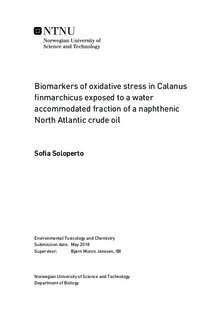Biomarkers of oxidative stress in Calanus finmarchicus exposed to a water accommodated fraction of a naphthenic North Atlantic crude oil
Master thesis
Permanent lenke
http://hdl.handle.net/11250/2503831Utgivelsesdato
2018Metadata
Vis full innførselSamlinger
- Institutt for biologi [2613]
Sammendrag
Calanus finmarchicus is an ecologically important species in the North, Norwegian and Barents Seas, periodically constituting up to 90% of the standing stock of zooplankton. Due to continued development of areas for oil and gas production, there are environmental discharges of contaminants occurring both continuously and accidentally in these areas. Existence of reliable biomarkers for oil exposure are fundamental for monitoring programs and decision-making processes in case of environmental discharges and oil spills. To assess the potential negative effects of oil exposure on keystone component of marine ecosystems, adult females of Calanus finmarchicus were exposed to the water-accommodated fraction (WAF) of a naphthenic North Atlantic crude oil. Adult non-ovulating females from the continuous lab culture at SINTEF/NTNU Sealab, were exposed without feeding to sub-lethal concentration of WAF in seawater and collected at 5 different time points 0, 24, 48, 72 and 96 hours. Several oxidative stress biomarkers were tested with gene expression (qPCR), enzymatic activity analyses and lipid peroxidation assay for malondialdehyde (MDA) concentrations. Enzymatic assays demonstrated induction of glutathione S-transferases (GST) and increase of glutathione (GSH) and MDA concentrations at each time point sampled. Gene expression results showed inconsistent responses with both up- and downregulation of GST at 48 and 72 hours and downregulation of superoxide dismutase (SOD) at 72 hours. Our study indicates that GST enzymatic activity, and GSH and MDA concentrations can be applied as a biomarkers of crude oil exposure in C. finmarchicus, while SOD gene expression is less suitable.
